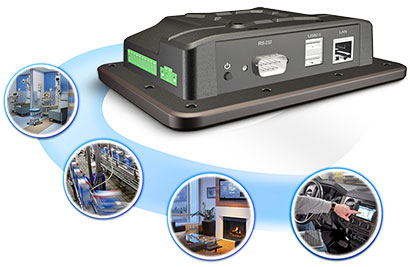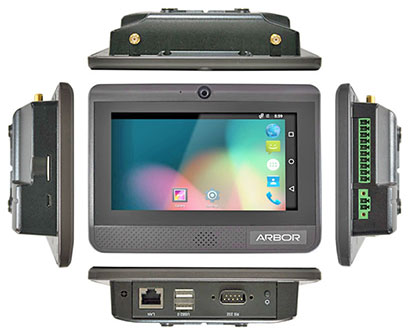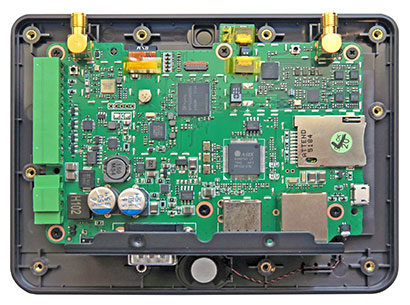ARBOR Technology modestly calls their new IoT-500 a "5-inch RISC-based Panel PC." They also call it an HMI panel, where HMI stands for Human Machine Interface. It's both of these, but it's really a whole lot more. ARBOR goes on to say that the IoT-500 provides great flexibility and compatibility "no matter what system you need to control or monitor." And that gets to what the IoT-500 is all about. It's a neat way for people to interact with the emerging Internet of Things.
The Internet of Things, or IoT, of course, is the hugely promising vision of a world where internet communication is no longer limited to people communicating with people or machines with machines, but where "things" communicate as well. These things — vehicles, doors, wash machines, fuel injectors, locks, cameras, or entire offices or homes — collect data via sensors, and then pass that data on for information, processing and action.
The ARBOR IoT-500's role is to display data from all sorts of sensors, and, if need be, allow human feedback. Easy as that. And very important.

So what does such a miraculous box look like, and what's in it? It's small, just 5.9 x 4.3 inches, and only weighs 13 ounces or so. It technically is a little panel PC, but one that runs Android 5.1 and has a very nice 5-inch screen with capacitive multi-touch. And just like in any modern smartphone, flush glass extends well beyond the perimeter of the LCD screen, so that your fingers can easily operate it without bopping into a frame.
Turn the little device around, though, and it shows its industrial side. There are full-size PC ports and industrial block connectors. The picture below shows what the IoT-500 looks like from all sides.

The connectors along the bottom are familiar: a couple of USB 2.0 ports, an RJ45 LAN jack for Ethernet, a legacy DB9 serial port that's software switchable to RS232, RS422 and RS485. The green industrial-looking terminals on the right side are for power (the IoT-500 doesn't have a battery), and for digital I/O and a CAN Bus and OBD-II interface. Digital I/O lines can be used to interact with all sorts of equipment and sensors. CAN Bus is an electronic bus standard for vehicles, and OBD-II is a standard interface for onboard diagnostics. A vehicle dock and screw-on antennae (see sidebar) are optionally available.
To stay on the technical side of things for a moment, the ARBOR IoT-500 is powered by a dual-core MediaTek MT2601 System on Chip, which the company calls an IoT solution chipset. There's 512MB of RAM, 4GB of onboard eMMC storage, a frontal 2mp camera, GPS, Bluetooth 4.1, state-of-the-art 801.11a/b/g/n/ac WiFi, and optional mobile Broadband. Below is what it all looks like inside:

The picture on top of this article gives you an idea of what ARBOR has in mind with the IoT-500. It can be connected, directly or wirelessly, to all sorts of vehicular, commercial, and industrial equipment, and act as an instrument panel or dashboard for them. Thanks to its bright, high-res 960 x 540 pixel display (that's 220 ppi, as good as a "retina" Apple iMac or MacBook), the IoT-500 can display detailed, complex systems data and sensor readings. And thanks to its projected capacitive touch interface, it allows for easy human monitoring, interaction, response, and control.
The IoT-500 isn't a mobile device in the sense that people carry it around, but it's certainly mobile in vehicles. So ARBOR gave it a wide 14 to 122 degree Fahrenheit (-10 to 50 degrees Centigrade) operating temperature range. The front panel is IP65-sealed, which means it's totally immune to dust and can also handle low pressure water jets. Drop spec isn't important in a device like this, but we'd like to see vibration resistance data in the specs.
Where can it be used? Almost anywhere. The polymer plastic housing is quite tough. It has a VESA 50 x 50 mm screwhole pattern on its back, which means that there's a limitless number of mounting solutions available for it. Since it's designed like a little panel computer it can also easily be integrated into a dash or panel anywhere.
An application example is shown in the sidebar. In a Southeast Asia metropolitan area, an ARBOR GPS-based in-vehicle solution with ARBOR IoT-500 units lets dispatchers assign taxi requests from call centers faster and more accurately, allocating them to the nearest available taxi drivers, and allowing drivers to immediately respond to bids for ride orders and locate their prospective passengers within the nearest pick-up points through GPS.
So that's ARBOR's IoT-500. It's clear that this clever little window into the Internet of Things can be used in a myriad of different ways. A sample app on our eval showed how the IoT-500 can search for, receive and display input from a great variety of sensors: heart rate, bikes, watches, fitness equipment, blood pressure, scales, temperature, vehicular, speed, pressure, acceleration, geocache, audio devices, remote controls, and so on.
The opportunities are endless.
ARBOR Technology Corp.
www.arbor-technology.com



